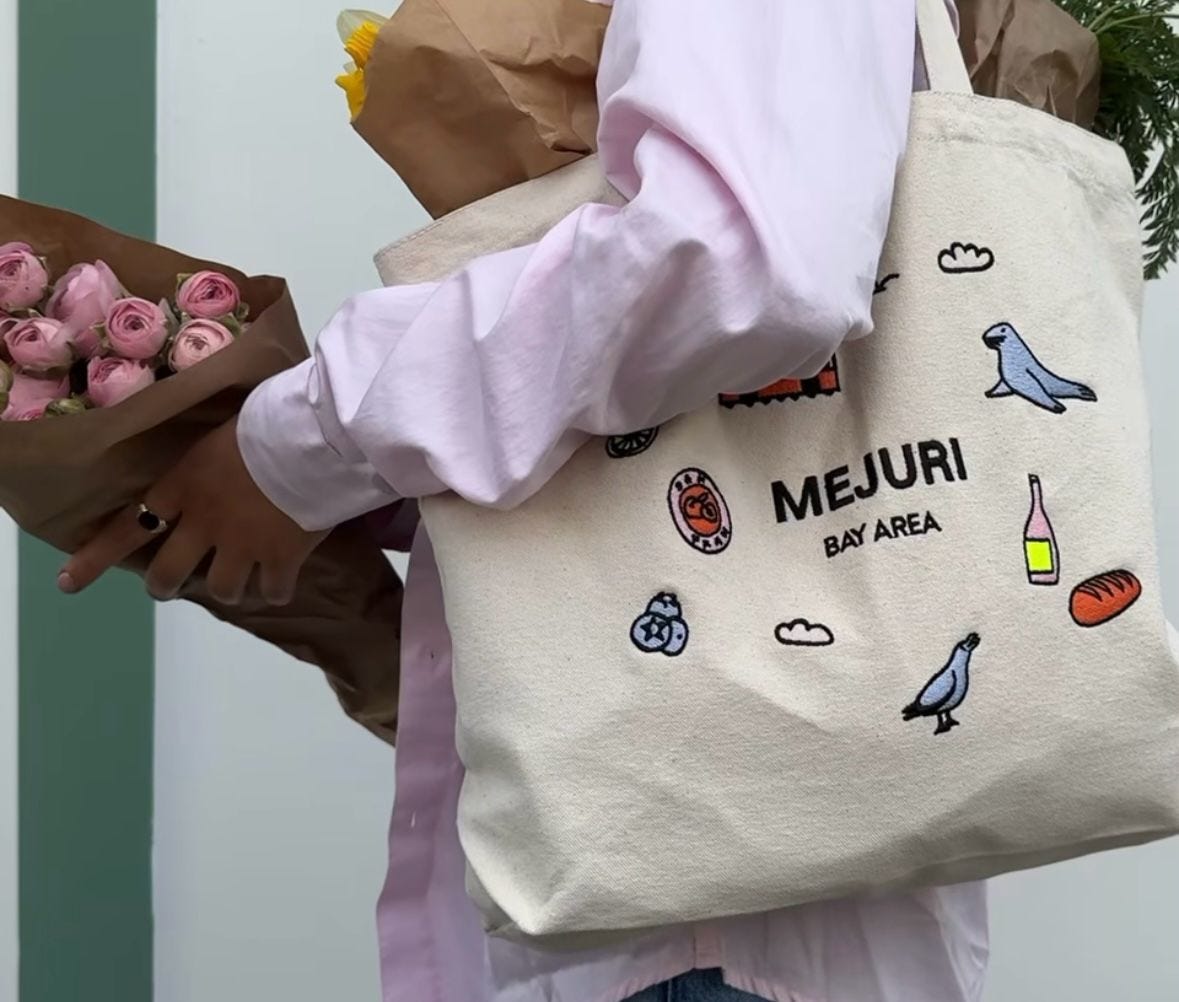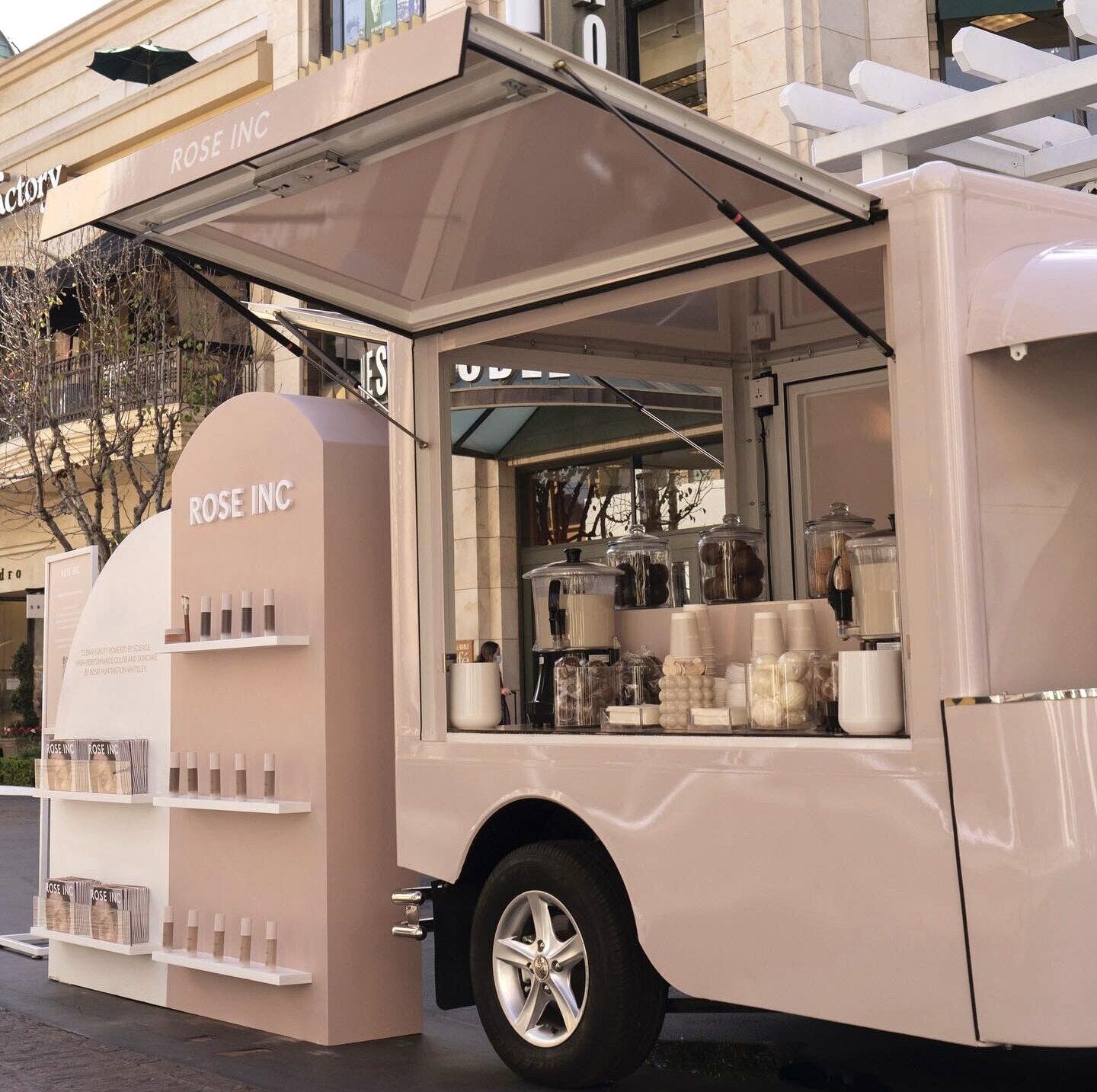Brands are hitting the road. Minimalist jewellery brand Mejuri announced their West Coast road trip this week and following SXSW Rivian x Ben & Jerry’s ice cream trucks have left Austin and are heading on a road trip around the US. But it’s not just for big brands (with big budgets), non-psychedelic mushroom brand - Alice Mushrooms rented a 1969 Chevrolet ice cream truck for a month and drove around California ending up outside Coachella festival.
Image: Alice Mushrooms Truck
Taking a brand on the road isn’t new - L.L. Bean has been crisscrossing the country in its 13-foot-high Bootmobile since 2012 (look here it’s exactly as it sounds) but this new wave of branded road trips is different. It’s scrappier, more experiential, and built for an audience that craves real-world connection over digital noise. A mobile brand moment doesn’t just deliver visibility; it creates something elusive in the age of endless content: talkability.
At a time when digital fatigue is peaking, the open road offers brands a new kind of marketing opportunity - one that trades static pop-ups for flexibility, surprise, and connection in places where traditional retail can’t reach. Whether it’s a high-traffic city or a small-town stop, college campuses, the most effective brands right now aren’t waiting for customers to come to them. They’re packing up and meeting them where they are.
why the brand road trip makes sense right now
The rise of the branded road trip isn’t happening in isolation - this shift toward mobility taps into several cultural and consumer trends:
the return of IRL experiences – years of hyper-curated, digital-first marketing have left consumers craving something more tangible. Road trips offer a raw, unfiltered form of brand engagement - spontaneous, personal, and rooted in real-world connection. They also allow brands to activate in places outside their usual strongholds, bringing the experience to consumers rather than waiting for them to show up.
the subtle shift away from influencer events - where brands once relied on influencer-dominated events to create buzz, there’s a shift toward treating consumers as the community. That means activations aren’t limited to influencer hubs like New York, London, LA, Sydney but can extend to smaller cities, suburban pockets, and unexpected locations.
nostalgia for slow travel – nostalgia remains one of the most powerful macro trends, and few things capture its spirit like a road trip. The romance of discovery, the open road, the joy of stumbling upon something unexpected - brands are tapping into this emotional appeal to create experiences that feel less transactional and more like an adventure.
retail reinvention on a budget – opening a new store is a massive investment. A road trip allows brands to test markets, create buzz, and meet consumers where they are—without the long-term commitment of a lease. It’s a lower-risk way to build brand presence in new locations and gauge interest before making a permanent move.
the rise of our small treat economy – consumers want small, joyful indulgences that don’t require a major purchase commitment. A free coffee, a limited-edition tote bag, or an IRL-only product drop turns a simple interaction created by the road trip into a moment worth sharing.
Image: Cute marshmallows and coffee given out at the Miu Miu truck
curation curation curation - some of the best travel recommendations don’t come from guidebooks - they come from people who work in brand and creative. As brands increasingly position themselves as curators of culture, a branded road trip doubles as a cultural itinerary, reinforcing the idea that these companies don’t just sell products- they shape experiences. (not related to road trips specifically but around the curator trend - I loved this vid talking about Glassette and
)brands as the new hosts - generosity isn’t just a nice-to-have; it’s an expectation. Today’s consumers don’t just want an opportunity to shop - they expect a great experience. Whether it’s a coffee from a brand pop-up or a small branded gift, photo booths etc thoughtful hospitality has become a key part of marketing strategy. This shift, from selling to hosting, signals a new approach to brand engagement, where meaningful interactions outweigh traditional sales tactics. Influencer platform Corq wrote about this trend.
hype culture - limited-edition merch, exclusive drops, and the excitement of being part of something in the moment - brand road trips tap into the same cultural appeal that makes sneaker releases and pop-ups so engaging. There’s a sense of connection in owning something tied to a specific place and time, whether it’s a cap you could only get at one stop or a tote from a one-day activation. These moments make brand experiences feel more personal, more memorable, and most importantly more worth sharing. The Rhode reusable water bottles given out at their London activation are even being sold on ebay. Similarly, Drink 818 Tequila’s merch, given out to the first people in the queue, quickly became a sought-after collectable - proof that the right exclusive giveaway works.
but why a road trip? the power of movement in brand marketing
for brands, visibility is the main driver behind hitting the road. Unlike structured, multi-stop “tours” where brands set up in predetermined locations - think Summer Friday’s recent activation in Bondi or Rhode’s city-based activations, vending machines etc - a true road trip is about the journey itself. The mobility factor is what makes this trend so dynamic.
cultural relevance in motion
the best brand road trips aren’t just about covering miles; they strategically integrate into culture. Hoka parking its truck at the Miami Marathon or Ben & Jerry’s kicking off its journey at SXSW ( I got the news from
here) aren’t just convenient stops - they reinforce brand relevance in a way that feels authentic and organic.
deepening consumer connection
beyond the Instagram moment, road trips facilitate real-world interactions. They bring brands to communities that might otherwise be overlooked, from college campuses to smaller cities that aren’t on the typical pop-up circuit. It’s a shift from exclusivity to accessibility - an approach that feels more democratic, inclusive, and,ultimately, effective.
budget-friendly, high-impact
compared to a traditional pop-up or flagship expansion, a road trip is often more cost-effective while delivering a wider reach. It’s an opportunity to test new markets, meet fresh audiences, and create moments of discovery that static retail can’t always replicate plus if you get it right - it generates PR.
built-in brand partnerships
With each stop comes the chance to collaborate with local businesses, cafes, studios, and tastemakers creating a hyper-localised experience that feels personal and cool.
legitimacy + trust building
for emerging brands or products that require education - like Alice Mushrooms - face-to-face engagement helps bridge the gap between curiosity and conversion. Meeting consumers in person validated Alice’s brand legitimacy and allowed for deeper storytelling around the science behind the product. The truck wasn’t just marketing - it was a vehicle for brand trust, social virality, and direct sales growth. Read more here
who’s doing it well?
Some of the most interesting executions span fashion, beauty, wellness, and even publishing:
penguin’s banned book wagon - road tripping throughout the US for a second time, Penguin’s road trip brings banned books directly to communities impacted by censorship. A purpose-driven activation that goes beyond selling a product, this initiative reinforces the power of books as cultural currency while sparking conversation. I love the intention behind this.
Mejuri’s west coast road trip - I love the way they’re bringing in social content, merch (all the good stuff we’ve been talking and being excited about) as well as local partners at each stop like Full Belly Farm (again connecting with that idea of the brand being curators)
Images: Mejuri instagram
Glossier’s Iconic Airstream “You Look Good” Campus Tour - it’s fairly popular for brands to do campus tours around September time in the US and a great way to do sampling, give out merch and collect data, set up ambassador programmes etc ( I did find this reddit thread with some thoughts from people who had attended) brands like Stanley, Notion, 818 tequila were also doing tours last year and it’s been something I’ve wanted to do for a long time.
Proving you don’t need to be selling a brand or product but an idea in 2021 RepresentUS partnered with Gerry’s pizza on a 5 location tour where they intentionally handed out unevenly cut pizza slices to educate Americans on the subject of voting suppression also called “gerrymandering” Tactically choosing 5 state locations and 9 cities.
Summer Friday’s Ice Cream truck - this was a few years ago and created in response to covid restrictions it was also probably one of the earlier kick-offs as beauty products named after food eg Refy Oat Lip Balm, Rhode Strawberry Glaze (more here) and the sensory marketing trend went wild. It might feel a little done now but I do think sometimes a simple ice cream is all we’re looking for from brand activations - we just want to connect!
what’s on the map/road ahead for the trend?
brand road trips aren’t just a one-off gimmick; they represent a larger shift in how brands engage with consumers here’s where I think it’s going…
more intimate, exclusive stops – I think we’ll start seeing fewer big city events, more unique, off-the-beaten-path locations. I think this ties in with the conversations we’re having about travel experiences and people seeking uniqueness.
bigger storytelling components – think travel documentaries, behind-the-scenes content, and audience-driven roadmaps. Tying into the trend for serialisation of content like a tv show. We’ll see brands maximising the moment.
collab road trips – two brands teaming up for a multi-category experience (e.g., fashion + food, beauty + wellness) again it feels like partnerships are very much on everyone’s minds at the moment and this is an interesting way to do it whether it’s parking outside a store, giving out specific products with another brand.
further integration of gamification - I think we’ll see brands look to get their consumers involved whether they are on the stops or not via gamifactions, guessing the location, treasure hunts.
sustainable road trips – EV-powered activations, carbon-offsetting programs, and upcycled pop-up spaces will become more of an expectation, especially for brands with sustainability at their core.
Whether it’s a vintage ice cream truck, a retro airstream, or a fleet of vintage soft top cars, the key takeaway is this: brands are going where their consumers are. In a landscape where physical stores feel like a commitment and digital marketing feels oversaturated, mobility offers a new way to create excitement, exclusivity, and community and creates buzz.
The question isn’t whether brand road trips are here to stay - it’s how brands will continue to innovate and surprise us on the journey.
directory - if you’re thinking about an activation
many brands have taken the DIY route, creating their own activations. While I haven't personally worked with these companies, here are some examples that might be good as a starting point -
Barlow & Sons looks like they worked on the Glossier Airstream
Food Truck Promotions - source location licenses, partnerships, staffing
Promotion Vehicles - love the idea of taking a landrover defender around the UK
Creator Maker - experiential events company
Image: Rose Inc










